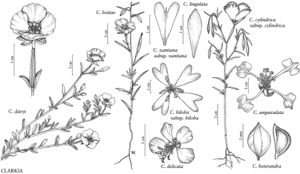familyOnagraceae
subfamilyOnagraceae subfam. Onagroideae
genusClarkia
sectionClarkia sect. Fibula
speciesClarkia xantiana
subspeciesClarkia xantiana subsp. xantiana
Difference between revisions of "Clarkia xantiana subsp. xantiana"
Treatment appears in FNA Volume 10.
imported>Volume Importer |
imported>Volume Importer |
||
| Line 42: | Line 42: | ||
|publication year= | |publication year= | ||
|special status= | |special status= | ||
| − | |source xml=https://xjsachs2@bitbucket.org/aafc-mbb/fna-data-curation.git/src/ | + | |source xml=https://xjsachs2@bitbucket.org/aafc-mbb/fna-data-curation.git/src/e39f0e846f172941159b2045254d62d10d9823f6/coarse_grained_fna_xml/V10/V10_402.xml |
|subfamily=Onagraceae subfam. Onagroideae | |subfamily=Onagraceae subfam. Onagroideae | ||
|tribe=Onagraceae tribe Onagreae | |tribe=Onagraceae tribe Onagreae | ||
Latest revision as of 11:32, 9 May 2022
Flowers: petals lavender to reddish purple, 12–20 mm; stigma exserted beyond anthers. 2n = 18.
Phenology: Flowering May–Jun.
Habitat: Dry slopes, woodlands, forest margins.
Elevation: 500–2000 m.
Discussion
Subspecies xantiana is known from the southern Sierra Nevada (especially Kern River drainage) and Tehachapi Mountain area in Kern and Tulare counties, and the Western Transverse Ranges in Los Angeles County.
Selected References
None.
Lower Taxa
None.
